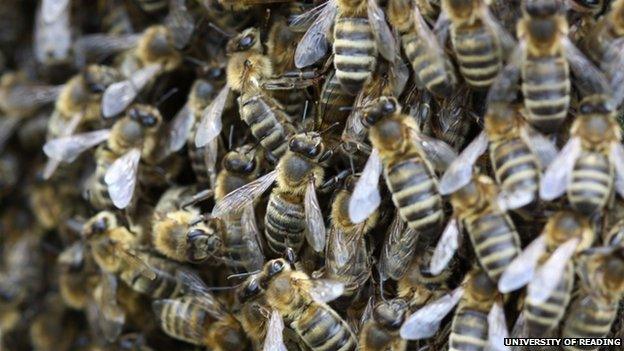Bumblebees infected with honeybee diseases
- Published

Bumblebees are in steep decline around the world but now they face an additional threat
The beleaguered bumblebee faces a new threat, scientists say.
Researchers have found that two diseases harboured by honeybees are spilling over into wild bumblebees.
Insects infected with deformed wing virus and a fungal parasite called Nosema ceranae were found across England, Scotland and Wales.
Writing in the journal Nature, external, the team says that beekeepers should keep their honeybees as free from disease as possible to stop the spread.
"These pathogens are capable of infecting adult bumblebees and they seem to have quite significant impacts," said Professor Mark Brown from Royal Holloway, University of London.
Around the world, bumblebees are doing badly.
In the last few decades, many species have suffered steep declines, and some, such Cullem's bumblebee (Bombus cullumanus) in the UK, have gone extinct.
Scientists believe that the destruction of their habitats - particularly wildflower meadows - has driven much of this loss, but the latest research suggests that disease too could play a role.

Researchers believe that honeybees are spreading diseases to bumblebees
The researchers looked at two pathogens commonly found in honeybees and found they can also infect adult bumblebees.
In honeybees, deformed wing virus (DWV) causes significant problems. Its severity seems to be exacerbated by the presence of another widespread parasite, the varroa mite, causing entire colonies to collapse.
Bumblebees do not carry the varroa mite, but the scientists found that those infected with DWV had a dramatically shortened lifespan. The fungal parasite has also been shown to have an impact on bumblebee longevity.
Prof Brown said: "A significantly shorter lifespan in the field would impact on their ability to go out and collect food and look after other bees."
The researchers found the diseases were already prevalent among wild populations.
Looking at 26 sites across Great Britain and the Isle of Man, the researchers found that about 11% of bumblebees were infected with DWV and 7% were infected with the fungus. By comparison, about 35% of honeybees carried DWV and 9% had the fungus.
"A geographical patterning provides us with the information that transmission is occurring among these animals - they are sharing parasite strains," said Prof Brown.
"We cannot say it definitively, but because of the epidemiology, the most likely explanation is that the honeybees are acting as the source of the virus for the bumblebees."
The team suspects that the same pattern will also be found around the world - and says that controlling disease in honeybee hives is vital to stopping the spread.
"We have to, at national and international levels, support management policies that enable our beekeepers to keep their bees as free of diseases as possible," Prof Brown said.
"The benefits are not just to the honeybees, they are to the wild bees as well."
Dr David Aston, president of the British Beekeepers Association (BBKA), said: "By employing good husbandry practices, beekeepers can take steps to reduce the impact of pests and diseases on honeybee colonies using biotechnical controls and practices such as apiary hygiene, regular brood comb changes, ensuring the colonies are strong and well-nourished and the use of authorised treatments."
But he added: "Beekeepers need new effective medications and other biotechnical controls to help in the management of bee pests and diseases and these should be a high-priority action."

The team thinks the diseases are transmitted when the insects visit the same flowers
The researchers also want to investigate whether neonicotinoid pesticides are playing a role in problem.
A recent paper in the Proceedings of the National Academy of Sciences, external journal suggested that the chemicals are affecting the immune systems of honeybees, making them more susceptible to pathogens.
"If bumblebees were exposed to neonicotinoids and had the same effect, you would expect the bumblebee viral load to be going through the roof. This is something we are hoping to test later," said Prof Brown.
In the European Union, neonicotinoids have been banned for two years because of fears that they may be harmful to bees. But the British government strongly opposed the plan, rejecting the science behind the moratorium. Both Syngenta and Bayer, which manufacture neonicotinoids, are now taking legal action against the European Commission in an effort to overturn the ban.
Follow Rebecca on Twitter, external
- Published29 April 2013
- Published17 September 2013
- Published18 July 2013
- Published9 January 2014
- Published17 December 2013
- Published2 August 2013